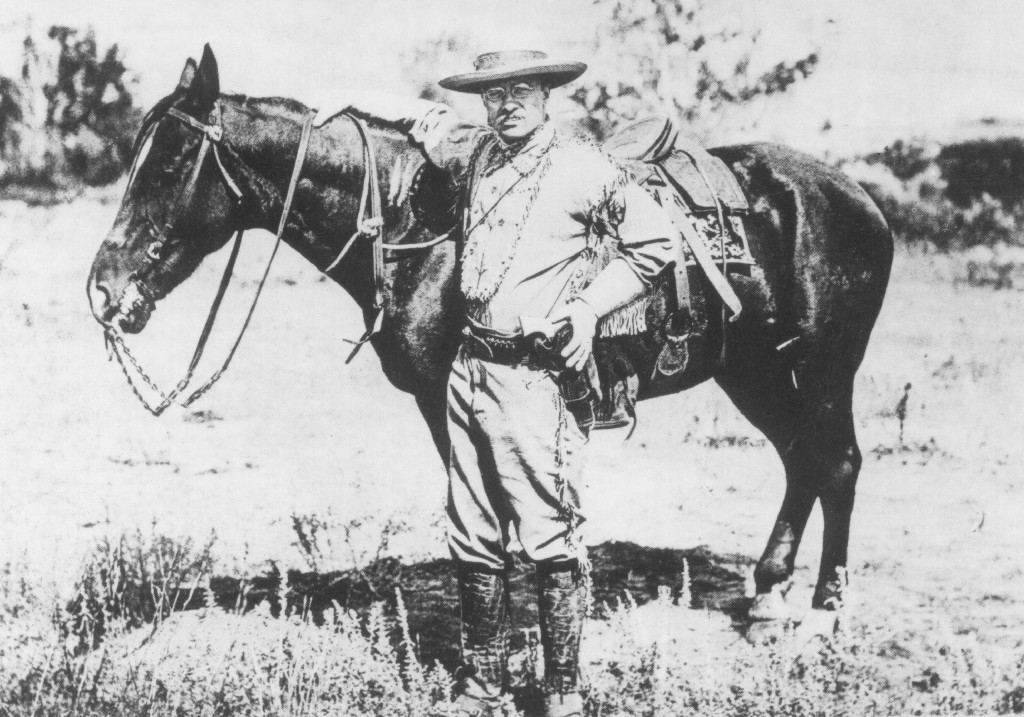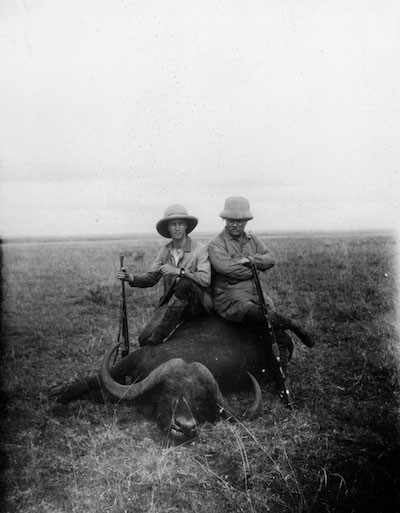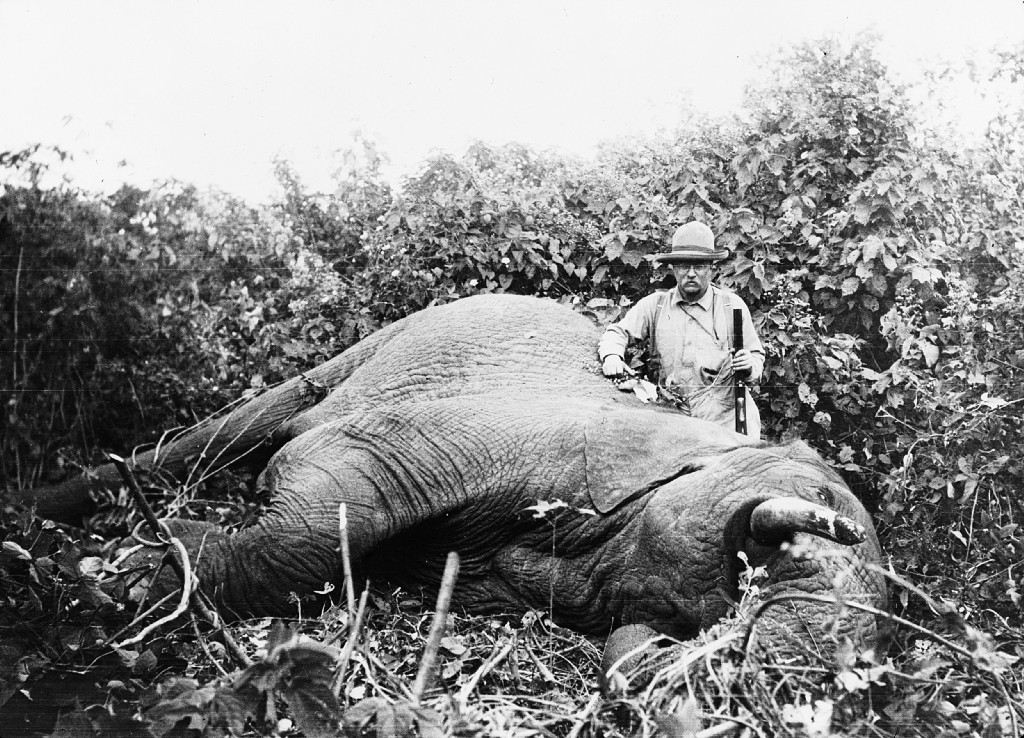There Must Be Something to Shoot
by Ben Jackson

In September of 1883, Theodore Roosevelt was determined to shoot a buffalo “while there were still buffalo left to shoot.” He was twenty-four years old and had just completed his second term as the youngest assemblyman in the history of New York State. It had not been a good year: As the leader of a weak minority, he’d had little power in the House, so his legislative program got nowhere, despite his grandiose speeches. He was also mocked for his dandyish manner and expensive clothes; the press referred to him as “Oscar Wilde,” “his Lordship” and “the exquisite Mr. Roosevelt.” By the end of the year, he had a point to prove. “Give a sissy a gun,” Gore Vidal would later remark, “and he will kill everything in sight.”
Roosevelt went west to the town of Little Missouri in the Dakota badlands, where he hired a guide, Joe Ferris, and set out among the buttes and mesas. The conditions were atrocious. Torrential rain alternated with barren, hot stillness. While traversing a steep bluff, the sodden soil gave way under the hooves of his horse and Roosevelt went tumbling to the bottom. One night, they woke lying in four inches of water. Ferris rolled over to find Roosevelt sitting up, muttering, “By Godfrey, but this is fun!” After twelve days of almost unmitigated suffering and several missed opportunities, Roosevelt, as he recounts in Hunting Trips of a Ranchman, finally bagged his prize:
There below me, not fifty yards off, was a great bison bull. He was walking along, grazing as he walked. His glossy fall coat was in fine trim and shone in the rays of the sun, while his pride of bearing showed him to be in the lusty vigour of his prime. As I rose above the crest of the hill, he held up his head and cocked his tail to the air. Before he could go off, I put the bullet in behind his shoulder.
Roosevelt followed the animal as it lumbered over the ridge, and in the next gully found it lying “stark dead.” He became delirious with joy and danced around the carcass letting out great whoops. “I never saw anyone so enthused in my life,” Ferris later recalled.
Despite the scarce buffalo, Roosevelt was so enamored of life in the West that he bought into a ranch and returned frequently to hunt or help with the cattle. His love of carnage — one hunting trip saw him land a hundred and seventy “items,” including several species of deer (“2 blacktail bucks with a single bullet”), two adult grizzlies, and a bear cub, which he proudly reported he shot “clean through… from end to end” — didn’t blind him to the fact that game and bird species seemed to be in continuous decline. During a hunting trip in 1887, four years after his first hunt, he noticed that the once-thriving herds of elk, bighorn, and pronghorn had been almost wiped out. There were no new beaver lodges, hardly any grizzlies, and many of the migratory bird species that Roosevelt enjoyed watching had failed to return for the season.
As he rode further into the badlands that fall, he found them virtually stripped of big game. Roosevelt’s long list of antagonists — on the left, people like Thomas Paine (a “filthy little atheist”), proponents of states’ rights like Thomas Jefferson (a “slippery demagogue”), and sheep (those “bleating idiots”) — swelled to include “unsportsmanlike” and “market” hunters: men who would shoot birds for the millinery trade, and big game only for their hides. He railed against those “swinish game butchers… too lazy to earn in any other and more honest way.” When he returned to New York, he was convinced that American big game was on the edge of extinction, and became determined to do something about it. It was the beginning of a process that would eventually lead him, as president, to protect over two hundred and forty-three million acres, one tenth of the entire United States — or an area four times the size of Britain.
On December 8th, 1887, Roosevelt organized a dinner for twelve wealthy men at his sister’s home on Madison Avenue. The company included his brother, Elliot; the son-in-law of John Jacob Astor, J. Coleman Drayton; and the editor of Forest and Stream (which would be absorbed by Field and Stream in 1930), George Bird Grinnell. Alongside Roosevelt, Grinnell was the driving force behind the evening. An experienced and strident conservationist, he had served as a naturalist on General Custer’s 1874 expedition to the Black Hills (he declined an appointment to the disastrous 1876 Little Big Horn expedition), and was later part of an early survey of Yellowstone National Park. In 1876, he founded the first Audubon Society, which gained a large and prominent membership, and was having some success in promoting the appreciation of birds. Roosevelt and Grinnell had been tossing about ideas on the subject of big game conservation since Roosevelt published Hunting Trips of a Ranchman in 1886. Their early discussions had been enjoyable, but useless. “We regretted the unnecessary destruction of game animals,” Grinnell wrote, “but we did not know all it meant, nor had we the vision to look forward and imagine what it portended.” Now, after his experiences in the West, Roosevelt believed he had been witness to an impending disaster, and that he knew what he had to do to prevent it. That evening, he proposed to his associates that they form a “fair chase” hunting club, devoted to “manly sport with a rifle.” More to the point, the club would “work for the preservation of the large game of this country, further legislation for that purpose, and assist in enforcing existing laws.”
The idea was met with enthusiasm, if not, at first, complete seriousness: According to Jonathan Spiro, one person suggested calling the club “The Swappers,” since they intended to spend their time swapping stories about their hunts. Roosevelt wanted to call the organization the “Boone and Crockett Club” after two of his Western heroes, Daniel Boone and Davy Crockett; he quickly won out, and the club set about formally organizing. By January 1888, it had a constitution that detailed its objectives and limited permanent membership to a hundred hunters who had each killed at least three American big game species “with the rifle, in fair chase.” These were all to be men who desired nothing more than to revive the struggling species of American big game — so that they could kill them. (“If there is to be any shooting there must be something to shoot,” as Roosevelt pointed out.) Roosevelt, of course, was named the organization’s president.

The club quickly became a hit in aristocratic social circles of the northeast. “The members of the club, so far as it is developed, are all persons of high social standing,” read an editorial in Forest and Stream (which Grinnell later admitted he made “the mouthpiece of the Boone and Crockett Club”). Permanent and associate members included artists, industrialists, military officers and political leaders: William Tecumseh Sherman was one of the Union Army’s most notorious Generals during the Civil War; Albert Bierstadt was a celebrated painter; Carl Schurz was the Secretary of the Interior from 1877 to 1881; and Henry Cabot Lodge, one of Roosevelt’s closest friends, was a member of the House who would go on to a thirty-one-year career in the Senate. These were the type of American patrician, Forest and Stream added, whose opinions were “worth regarding.”
The club directed its hostility wherever Roosevelt pointed. Unsportsmanlike hunters were especially disgusting — the type of men who would use lanterns to hypnotize game in the dark (“jacking”), or who would happily shoot an animal struggling helplessly through deep snow (“crusting”) — because they refused to understand that hunting was a matter of honour, not of economic imperatives; it was the quality of the chase, not the quantity of the carcasses, that counted. Members of the club got to work bringing these unethical hunters low, and with Roosevelt pre-occupied with government work, one man especially carried the fight: Madison Grant, who had been nominated for membership by Grinnell in 1893.
Grant was a young and charismatic lawyer who was deeply worried about the decline of forests and big game species in the United States. He was also an unconscionable racist, a white supremacist who warned of the decline of “Nordic” peoples. Among his works is The Passing of the Great Race, which was referenced by Anders Breivik, the Norwegian terrorist, in his 2011 manifesto, and which Hitler referred to as his “bible.” Roosevelt thought it a “capital book,” and that Grant was a “good fellow.” Together they fretted about the new railways that were bringing the wrong sort of hunters to upstate New York and the Adirondacks. Grant, at Roosevelt’s suggestion, descended on the New York State legislature in Albany to fight for new regulations. He lobbied furiously to pass the Adirondack Deer Bill, which would ban practices like jacking and using dogs to drive game into lakes where they could be easily shot.
In opposition, an alliance of railroad companies, market hunters, and Adirondack guides formed. They framed their argument in populist terms: For the locals, hunting was a matter of subsistence. Why should a group of New York aristocrats be able to impose their will on the poor men of the Adirondacks? Grant was immune to such criticism. “He was not at all uncomfortable being labelled an elitist,” Jonathan Spiro notes in his account of Grant’s life, Defending the Master Race. Roosevelt, by contrast, liked to think of himself as a champion of the common man, but never on an issue of this kind, which not only pitted the common man against the wild things he greatly cared for, but also touched dangerous notions of states’ rights and nullification.
Grant continued to press his case through a number of defeats. It took him three years of lobbying, letters, and articles before finally, in 1897, his Deer Bill became law. Roosevelt wrote to him ecstatically: “I am extremely pleased with what you have accomplished.” From the club’s perspective, he was right to be. Deer populations began recovering, and beavers and bears moved back into the area. Soon, other state legislatures were following suit. “Grant,” Spiro writes, “had gone a long way toward ending unsportsmanlike hunting in the United States.”
The club had a number of other early successes. One of its preoccupations was Yellowstone National Park. The 1872 act that created the park had neglected to include any enforcement mechanisms, so poaching was rampant. Its second superintendent, Philetus Norris, ventured a guess that over four thousand elk were killed in the winter of 1874 in the Mammoth Springs Basin alone. “Their carcasses and branching antlers can be seen on every hillside and on every valley,” he wrote. Worse, by 1883, the Northern Pacific Railroad had extended its line close to the border of the park, making it more accessible to the general public. Commercial hunters were moving in, and developers were starting to see the potential of using Yellowstone as a resort. Boone and Crockett members organized against the dabblers and the tourists, and in 1894, one member, Congressman John Lacey, sponsored a bill that, for the first time, gave the Department of the Interior the authority to arrest and prosecute poachers and other violators in Yellowstone.
Another of the club’s concerns was forests, and when the American Forestry Association started pushing for protection of Western woodlands, Roosevelt invited members to pile into the fight. Largely as a result of their efforts, Congress passed the Forest Reserve Act of 1891, which stated that “the President of the United States may, from time to time, set apart and reserve, in any state or territory having public land, bearing forests… whether of commercial value or not, as public reservations.” Benjamin Harrison, who was president in 1891, used the act to declare thirteen million acres of forest as national reserves. Grover Cleveland added another twenty-five million acres and William McKinley proclaimed seven million. Roosevelt thought his predecessors’ achievements wholly inadequate. When he became president in 1901, he topped them all, setting aside more than a hundred and fifty million acres of forest as public reservations. It was, all things considered, one of the most significant pieces of conservation legislation in the history of the United States.
Roosevelt’s administration was marked by the influence of the Boone and Crockett Club’s philosophy and members. Most significantly, Gifford Pinchot, Roosevelt’s chief forester, pushed an attitude to conservation that was a kind of generalization of the Boone and Crockett Club’s attitude toward big game: American forests and natural resources should be protected so that their use could be enjoyed in perpetuity. Pinchot believed in the scientific management of natural resources so that they produced the greatest public benefit; he once called forests a factory for trees. This marked a great fault line in U.S. conservation: On one side Pinchot, and on the other, the Sierra Club, founded in 1892 by John Muir, which promoted the preservation of wilderness not as a resource, but as an object of almost spiritual reverence.
Roosevelt sided with Pinchot. He opened forest reserves up to agriculture and grazing where he considered it to be in the public interest. When Muir fought against the construction of a dam in the Hetch Hetchy Valley in Yosemite (“as well dam for water-tanks the people’s cathedrals and churches, for no holier temple has ever been consecrated by the heart of man”), Roosevelt could have objected to the decision of his Secretary of the Interior, James Garfield, to grant San Francisco the right to develop the Tuolumne River. He decided not to. Despite these decisions, Roosevelt and Pinchot together pushed a remarkable conservation agenda. They doubled the number of national parks in the United States, creating Crater Lake, Wind Cave, Sullys Hill, Platt, and Mesa Verde National Parks. They quadrupled the number of national forests; created fifty-one federal bird reserves; and passed the Antiquities Act, which allowed Roosevelt to create eighteen national monuments (many of which went on to become national parks). More than any other president, Roosevelt encouraged a shift from the disposal of land to settlers and private interests, to the protection of public lands as reserves.
But while we can rightly celebrate many of the club’s achievements, it’s as well to remember that they represented interests of a privileged few, and those interests remain embedded in many of the most important pieces of conservation legislation in the United States. The Boone and Crockett Club had its heyday before and during Roosevelt’s administration, but the club, its style of conservation, and the tone of its rhetoric has continued to be remarkably successful. “No attack on environmentalism, no proposal to loot the country’s natural assets,” Jim O’Brien, then an editor at Radical America, writes, “is complete without a phony-populist sneer at those who try to defend the environment.” But populism isn’t always phony: As Jedediah Purdy, a Professor of Law at Duke University, has written, “The major environmental statutes, such as the Clean Air Act and the Clean Water Act, were written with no attention to the unequal vulnerability of poor and minority groups.” Only recently, with the rise of the environmental justice movement, which highlights the unequal share of environmental benefits and risks between peoples of different incomes or races, is this beginning to be addressed.

The Boone and Crockett Club also began the argument, alive to this day, that hunters can be conservationists too. This notion is especially prominent in the wake of modern trophy-hunting controversies, such as the international outrage at the killing of Cecil the Lion, a major attraction in Hwange National Park in Zimbabwe, by an American dentist last July. Over the years, hunters have argued that trophy hunting helps local people through the sale of hunting licenses and by bringing rich hunters into an area. They maintain that this source of revenue dissuades locals from poaching animals, or converting important habitats into agricultural areas, and so helps wildlife populations. Opponents point out that encouraging safaris and other types of ecotourism achieves all these things without the slaughter; moreover, they find the notion of “killing to conserve” inherently repellent, in part because it allows conservation to become a fig leaf for bloodthirstiness. The Boone and Crockett Club, for its part, has stayed faithful to its founding philosophy: It promotes hunting, but opposes practices such as “canned shoots” (“often erroneously called canned hunts,” as the website puts it), in which the animal is kept in a confined area, a situation that offers the shooter “a certain or unrealistically favorable chance of a kill.”
Roosevelt never quite lost his love of hunting. On a trip to Yellowstone in 1903, he had to be talked out of a cougar hunt for fear of the bad publicity. In 1910, after he had left the presidency, he went on a long shooting trip in Africa with his son, Kermit; his party killed a total of eleven thousand, four hundred animals, including elephants, hippopotamuses and so many white rhinos that the Smithsonian, where Roosevelt was sending his specimens, had to start offloading their heads on other museums.
Seven years before the Africa hunt, Roosevelt went to Yosemite, where he took a backcountry trip with John Muir, who work him into fits of rage about the depredations of timber thieves who operated in the park. One night, when the conversation lulled, Roosevelt thought to entertain his guide with stories about big game hunts. In all his years, these had been reliable crowd pleasers, but Muir was underwhelmed. He asked Roosevelt if he had not yet gone beyond “the boyishness of killing things… Are you not getting far enough along to leave that off?” Roosevelt, looking over the campfire, had a moment’s pause. Then he said, “Muir, I guess you are right.”
